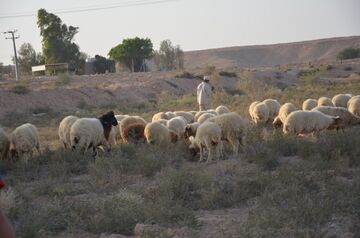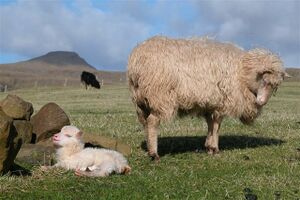غنم (جنس)
| Ovis | |
|---|---|
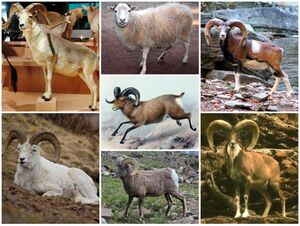
| |
| There are 7 species of Ovis. | |
| التصنيف العلمي | |
| أصنوفة غير معروفة (أصلحها): | الحياة |
| مملكة: | الحيوانية |
| Phylum: | حبليات |
| Class: | الثدييات |
| تحت فصيلة: | الوعليات |
| الجنس: | غنم Linnaeus, 1758 |
| Type species | |
| Ovis aries | |
| Species | |
|
See text. | |
الغنم Ovis هي من الثدييات المدجنة ونباتية من عائلة البقاريات والعائلة الفرعية الماعز. ويربي الإنسان الغنم من أجل لحومها، وحليبها، صوفها وجلدها الذي يصنع منه نوعية تدعى باسان.
وهي من الثدييات المجترة، ولا يكاد يوجد إلا الأليفة منها. ومثل باقي الحيوانات المجترة، تعتبر الأغنام من ذوات الأظلاف وتمشي على زوج من الأصابع سيتارتيوداكتيلا Cetartiodactyla من المحتمل جدا أن تنحدر من الأيائل الأوربية والآسيوية. وتعتبر من أوائل الحيوانات المستأنسة كما تستحب كثيرا لصوفها، وللحومها. صوف الغنم هو الشعر الحيواني الأكثر استخداما والذي يقطع بمجزات عادة (الجز).
تربّى الأغنام في جميع أنحاء العالم ولعبت دورا أساسيا في العديد من الحضارات. أما في الوقت الحالي، تعتبر كل من أستراليا، نيوزيلندا، باتاغونيا والمملكة المتحدة المناطق الرئيسية التي تكرس لتربية المواشي.
وهو حيوان أساسي في التاريخ الزراعي، وللغنم أثر كبير في ثقافة الإنسان. وهو حاضر في العديد من الأساطير، كما تعطي كثير من الأديان الرئيسية أهمية كبيرة لها، وخاصة الديانات الإبراهيمية. وبالأخص عند المسلمين فهو الأضحية المفضلة لعيد الأضحى. ذكر الغنم يسمى كبش وخروف وأنثاها تسمى نعجة وصغيرهما يعرف بالحمل.
وردت كلمة غنم ونعجة ونعاج في القرآن الكريم في عدة آيات، وقد حلل الله ذبحها وأكل لحومها، ولها أهمية خاصة حيث يضحى بها في الحج وعيد الأضحى والمناسبات الأخرى.
. . . . . . . . . . . . . . . . . . . . . . . . . . . . . . . . . . . . . . . . . . . . . . . . . . . . . . . . . . . . . . . . . . . . . . . . . . . . . . . . . . . . . . . . . . . . . . . . . . . . . . . . . . . . . . . . . . . . . . . . . . . . . . . . . . . . . . . . . . . . . . . . . . . . . . . . . . . . . . . . . . . . . . . .
أسماء الغنم
الغنم جمع لا مفرد له ولكن له تثنية فيسوغ قول غنمان، تنقسم الغنم إلى ذوات صوف وتدعى الضأن وصوتها ثغاء وتؤاج (باع) وهناك الغنم ذوات الشعر وتدعى الماعز وصوتها يعار ونبيب (مااء). صغار الغنم تسمى سخال والواحد منها سخلة. ذكر الضأن يدعى الكبش أو الخروف وفي الحجاز يسمى طلي أما في تونس يسمى علوش و عند تمامه الحول الأول حولي و السنة الثانية بركوس ثم كبش و الكبش أكبر من الخروف سنا وأنثاه تدعى الشاة أو النعجة والنعجة تطلق على أنثى الضأن والبقر وحمار الوحش. الذكر الصغير من الضأن يسمى حمل والأنثى الصغيرة تسمى رخل أو نعجة . أم بالنسبة للماعز فالذكر منه تيس والأنثى معزة أو عنزة. ويدعى التيس الصغير بالجدي والأنثى الصغيرة بالعناق.
Characteristics
Sheep are fairly small compared to other ungulates; in most species, adults weigh less than 100 kg (220 lb).[1] Males are usually heavier than females by a significant amount. Wild sheep are mostly found in hilly or mountainous habitats. Their diets consist mainly of grasses, as well as other plants and lichens. Like other ruminants, they have four-chambered stomachs, which play a vital role in digesting food; they eructate, and rechew the cud to enable them to digest and live on low-quality, rough plant materials. Sheep conserve water well, and can live in fairly dry environments.
The bodies of wild sheep (and some domestic breeds) are covered by a coat of thick hair to protect them from cold. This coat contains long, stiff hairs, called kemps, over a short, woolly undercoat, which grows in autumn and is shed in spring.[2] This woolly undercoat has been developed in many domestic sheep breeds into a fleece of long wool, with selection against kemp hairs in these breeds. The fleece covers the body (in a few breeds also the face and legs) and is used for fibre. Domestic sheep are also reared for their milk and meat (which is called lamb or mutton depending on the age of the animal).
In wild sheep, both rams and ewes have horns, while in domestic sheep (depending upon breed) horns may be present in both rams and ewes, in rams only, or in neither. Rams' horns may be very large – those of a mature bighorn ram can weigh 14 kg (31 lb) – as much as the bones of the rest of its body put together. Rams use their horns to fight with each other for dominance and the right to mate with females. In most cases, they do not injure each other because they hit each other head-to-head, and their curved horns do not strike each other's bodies. They are also protected by having very thick skin and double-layered skulls.[3]
Wild sheep have very keen senses of sight and hearing. When detecting predators, wild sheep most often flee, usually to higher ground, but they can also fight back. The Dall sheep has been known to butt wolves off the face of cliffs.[3]
Sheep have scent glands on their faces and feet. Communication through the scent glands is not well understood, but is thought to be important for sexual signaling. Males can smell females that are in estrus, and rams mark their territories by rubbing scent on rocks.
Species
Seven species (and numerous subspecies) of sheep are currently recognized. The main recognized divisions are:[4]
| Image | Scientific name | Common Name | Distribution |
|---|---|---|---|
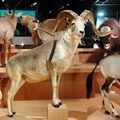 |
Ovis ammon | Argali | central Kazakhstan in the west to the Shanxi Province in China |
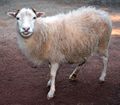 |
Ovis aries[5] | Domestic sheep | Domesticated |
 |
Ovis canadensis | Bighorn sheep | North America |
 |
Ovis dalli | Dall sheep | northwestern North America. |
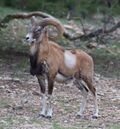 |
Ovis gmelini | Mouflon | eastern Turkey, Armenia, Azerbaijan, and Iran |
 |
Ovis nivicola | Snow sheep | northeast of Siberia |
 |
Ovis vignei | Urial | Central and South Asia. |
السلوك
Sheep are social animals and live in groups, called flocks. This helps them to avoid predators and stay warm in cold weather by huddling together. Flocks of sheep need to keep moving to find new grazing areas and more favourable weather as the seasons change. In each flock, a sheep, usually a mature ram, is followed by the others.[2] This "leader to follower" relationship can be both a positive and negative for flocks of Ovis aries. Although there is safety in numbers, it has been reported that the following of one mature ram can bring flocks to slaughter in many situations where the mature ram misguides the flock.[6][7]
التزاوج
Mating in sheep is characterized by males competing for females in estrus.[8] Social rank in rams is established by male-male competition, known as the rut.[9] Females select from dominant males based on sexually selected characteristics such as body size and horn size, as those traits are desirable in offspring.
Females typically are separated from males outside the rut, but during the rut, females and males are found together.[9] Females that are oestrous isolate themselves from other ewes, and may be less mobile.[9] The rut is also linked with different ewe behaviour than during nonrutting periods.[9] These changes are characterized by decreased feeding, increased time observing their surroundings, and increased behaviour changes.[9] Ewes are also predicted to be slightly receptive to the displays of the rams.[9]
انظر أيضاً
- Aries, the Ram (astrological sign)
- Barbary sheep (Ammotragus lervia) another type of Caprinae
- Pseudois, a genus with one species of Caprinae, the bharal, or blue sheep
المراجع
- ^ Nowak, R. M. and J. L. Paradiso. 1983. Walker's Mammals of the World. Baltimore, Maryland: The Johns Hopkins University Press. ISBN 0-8018-2525-3
- ^ أ ب Clutton-Brock, J. 1999. A Natural History of Domesticated Mammals. Cambridge, UK : Cambridge University Press ISBN 0-521-63495-4
- ^ أ ب Voelker, W. 1986. The Natural History of Living Mammals. Medford, New Jersey: Plexus Publishing, Inc. ISBN 0-937548-08-1
- ^ خطأ استشهاد: وسم
<ref>غير صحيح؛ لا نص تم توفيره للمراجع المسماةMSW3 - ^ ICZN (International Commission on Zoological Nomenclature) Opinion 2027
- ^ Kawai, Kaori (1989). "The flexible grouping and behavioral character of a flock of Suffolk ewes (Ovis aries)". Journal of Ethology. Journal of Plant Pathology. 7: 41–51. doi:10.1007/BF02350581. S2CID 36036030. Retrieved 26 March 2021.
- ^ Schoenian, Susan. "Follow The Leader". Sheep 101. Retrieved 26 March 2021.
- ^ Coltman, D; Festa-Bianchet, M; Jorgenson, J; Strobeck, C (2002). "Age-Dependent Sexual Selection in Bighorn Rams". Proceedings of the Royal Society B: Biological Sciences. 269 (1487): 165–172. doi:10.1098/rspb.2001.1851. PMC 1690873. PMID 11798432.
- ^ أ ب ت ث ج ح Gonzalez, Georges; Bon, Richard; Estevez, Imna; Recarte, Jose (2001). "Behaviour of Ewes (Ovis Gmelini Musimon x Ovis Sp.) During the Rut". Rev. Ecol. 56: 221–230.
- Bulanskey, S. 1992. The Covenant of the Wild. New York: William Morrow and Company, Inc. ISBN 0-688-09610-7
- Parker, D. 2001. The Sheep Book. Athens, Ohio, USA : Swallow Press / Ohio University Press ISBN 0-8040-1032-3
وصلات خارجية
خطأ: الوظيفة "t" غير موجودة.

